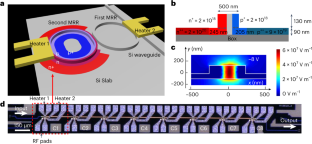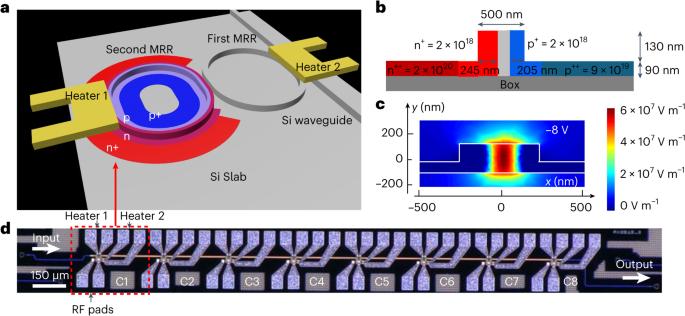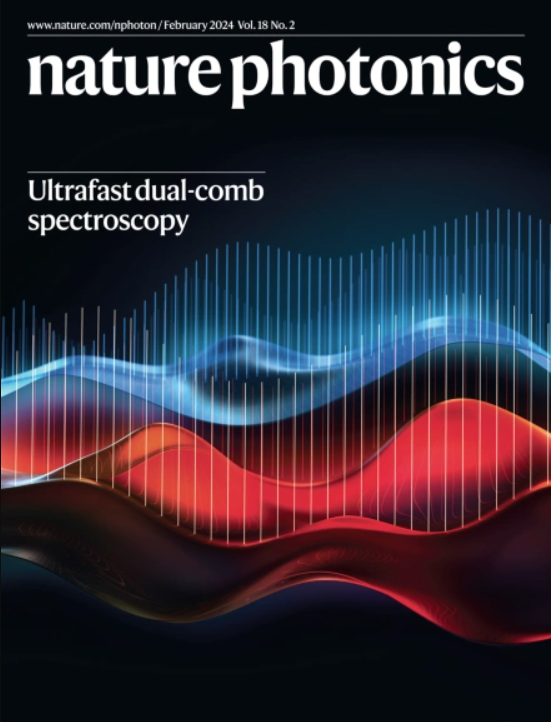An 8 × 160 Gb s−1 all-silicon avalanche photodiode chip
IF 32.3
1区 物理与天体物理
Q1 OPTICS
引用次数: 0
Abstract
In response to growing demands on data traffic, silicon (Si) photonics has emerged as a promising technology for ultra-high-speed and low-cost optical interconnects. However, achieving high-performance photodetectors with Si photonics requires integrating narrower-bandgap materials, resulting in more complex fabrication processes, higher costs and yield issues. To address this challenge, we demonstrate an all-Si receiver (RX) based on a cost-efficient, eight-channel, double-microring-resonator, avalanche photodiode. It has an aggregate data rate of 1.28 Tb s−1. All channels show excellent uniformity in their device performance with a responsivity of 0.4 A W−1, an ultra-low dark current of 1 nA, a high bandwidth of 40 GHz at −8 V and a $$k$$ value of 0.28. To the best of our knowledge, this is the first demonstration of an all-Si RX supporting a record-high transmission data rate of 160 Gb s−1 per channel, along with an ultra-low electrical crosstalk of less than −50 dB. This all-Si optical RX can compete with the commercial heterojunction-based RXs and promises ~40% chip cost saving, thus paving the way to realizing >3.2 Tb s−1 interconnects for future optical networks. Researchers demonstrate a receiver based on an all-Si eight-channel avalanche photodiode, which operates at a data rate of 160 Gb s−1 per channel and has an aggregate rate of 1.28 Tb s−1.


8 × 160 Gb s-1 全硅雪崩光电二极管芯片
为满足日益增长的数据流量需求,硅(Si)光子技术已成为一种前景广阔的超高速、低成本光互连技术。然而,利用硅光子技术实现高性能光电探测器需要集成更窄的带隙材料,从而导致更复杂的制造工艺、更高的成本和产量问题。为了应对这一挑战,我们展示了一种全硅接收器 (RX),它基于一个具有成本效益的八通道双微光谐振器雪崩光电二极管。它的总数据传输率为 1.28 Tb s-1。所有通道的器件性能都非常均匀,响应率为 0.4 A W-1,暗电流超低,为 1 nA,在 -8 V 时的带宽高达 40 GHz,(k/)值为 0.28。据我们所知,这是首次展示全硅 RX,支持每信道 160 Gb s-1 的创纪录高传输数据率,以及小于 -50 dB 的超低电气串扰。这种全硅光学 RX 可以与基于异质结的商用 RX 相媲美,并有望节省约 40% 的芯片成本,从而为实现未来光网络的 3.2 Tb s-1 互联铺平道路。
本文章由计算机程序翻译,如有差异,请以英文原文为准。
求助全文
约1分钟内获得全文
求助全文
来源期刊

Nature Photonics
物理-光学
CiteScore
54.20
自引率
1.70%
发文量
158
审稿时长
12 months
期刊介绍:
Nature Photonics is a monthly journal dedicated to the scientific study and application of light, known as Photonics. It publishes top-quality, peer-reviewed research across all areas of light generation, manipulation, and detection.
The journal encompasses research into the fundamental properties of light and its interactions with matter, as well as the latest developments in optoelectronic devices and emerging photonics applications. Topics covered include lasers, LEDs, imaging, detectors, optoelectronic devices, quantum optics, biophotonics, optical data storage, spectroscopy, fiber optics, solar energy, displays, terahertz technology, nonlinear optics, plasmonics, nanophotonics, and X-rays.
In addition to research papers and review articles summarizing scientific findings in optoelectronics, Nature Photonics also features News and Views pieces and research highlights. It uniquely includes articles on the business aspects of the industry, such as technology commercialization and market analysis, offering a comprehensive perspective on the field.
 求助内容:
求助内容: 应助结果提醒方式:
应助结果提醒方式:


